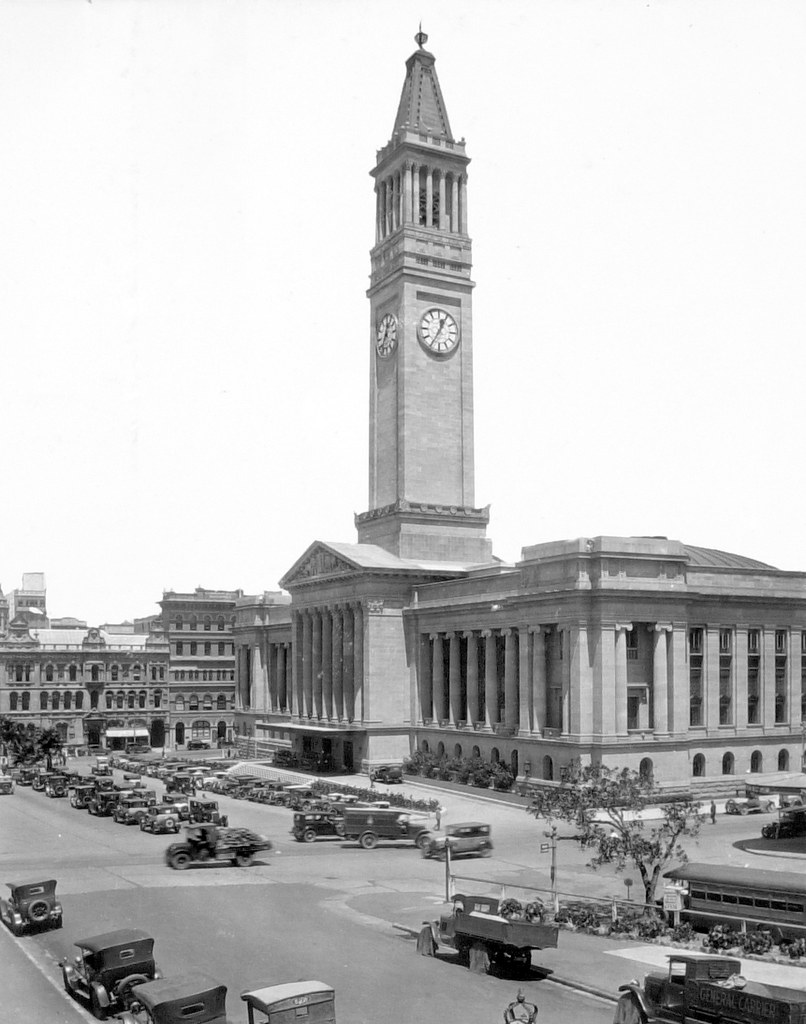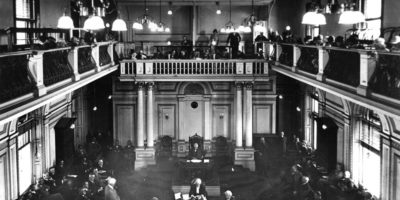08 May City Hall – Symbol of Brisbane
Think engineering in Brisbane and many significant landmarks come to mind – the Old Windmill, the Story Bridge, or the much more modern Brisbane Skytower, the tallest structure in Brisbane. But the building that has come to symbolise Brisbane is one that was for 30 years the tallest in Brisbane – City Hall.
Inaugurated on 8 April 1930, the vision for Brisbane City Hall began in 1909. Ratepayer opposition to the estimated £180,000 cost of construction calculated to around $25 million today and disagreement over its location saw plans delayed for almost a decade. The current site was settled by 1917 – the other potential site in Fortitude Valley was sold to the Catholic Church who planned to build the Holy Name Cathedral – with the laying of the first foundation stone by Queensland Governor Sir Hamilton Gould- Adams, despite there being no plans drawn.
Another two years passed before plans from architects Hall and Prentice were designed, submitted and approval given to the Italian Renaissance style building complete with chariot statues (construction costs were estimated at £460,000). A second foundation stone was laid by Edward, the Prince of Wales (later King Edward VIII / Duke of Windsor) in July 1920.
“…at the time was one Australia’s most expensive buildings…”
City Hall took 10 years to build and came at a cost of around £980,000. At the time it was one Australia’s most expensive buildings and the second largest construction project, behind only the Sydney Harbour Bridge.
RPEQ Russell McWilliam (RPEQ# 53) was the consulting structural engineer for City Hall. The only part of Brisbane City Hall not entirely McWilliam’s work is the auditorium dome. The design and building of City Hall incorporated many advanced technical elements for its time with a modern steel reinforced concrete column and beam structure. Local materials were used as much as possible in the construction – including granite from Samford and Enoggera and sandstone from Helidon.
Like Brisbane City Hall, the Board of Professional Engineers of Queensland is celebrating 90 Years in 2020. To celebrate this milestone BPEQ is acknowledging the significant projects like Brisbane City Hall and RPEQs such as Russell McWilliam that have contributed to the development of Queensland.
Brisbane City Hall is a remarkable engineering achievement. It is listed with the National Trust and included in the National Estate and the Queensland Heritage Act 1992 and also acknowledged by RPEQs who voted for Queensland’s greatest engineering feat.
Think engineering in Brisbane and many significant landmarks come to mind – the Old Windmill, the Story Bridge, or the much more modern Brisbane Skytower, the tallest structure in Brisbane. But the building that has come to symbolise Brisbane is one that was for 30 years the tallest in Brisbane – City Hall.
Inaugurated on 8 April 1930, the vision for Brisbane City Hall began in 1909. Ratepayer opposition to the estimated £180,000 cost of construction calculated to around $25 million today and disagreement over its location saw plans delayed for almost a decade. The current site was settled by 1917 – the other potential site in Fortitude Valley was sold to the Catholic Church who planned to build the Holy Name Cathedral – with the laying of the first foundation stone by Queensland Governor Sir Hamilton Gould- Adams, despite there being no plans drawn.
Another two years passed before plans from architects Hall and Prentice were designed, submitted and approval given to the Italian Renaissance style building complete with chariot statues (construction costs were estimated at £460,000). A second foundation stone was laid by Edward, the Prince of Wales (later King Edward VIII / Duke of Windsor) in July 1920.
“…at the time was one Australia’s most expensive buildings…”
City Hall took 10 years to build and came at a cost of around £980,000. At the time it was one Australia’s most expensive buildings and the second largest construction project, behind only the Sydney Harbour Bridge.
RPEQ Russell McWilliam (RPEQ# 53) was the consulting structural engineer for City Hall. The only part of Brisbane City Hall not entirely McWilliam’s work is the auditorium dome. The design and building of City Hall incorporated many advanced technical elements for its time with a modern steel reinforced concrete column and beam structure. Local materials were used as much as possible in the construction – including granite from Samford and Enoggera and sandstone from Helidon.
Like Brisbane City Hall, the Board of Professional Engineers of Queensland is celebrating 90 Years in 2020. To celebrate this milestone BPEQ is acknowledging the significant projects like Brisbane City Hall and RPEQs such as Russell McWilliam that have contributed to the development of Queensland.
Brisbane City Hall is a remarkable engineering achievement. It is listed with the National Trust and included in the National Estate and the Queensland Heritage Act 1992 and also acknowledged by RPEQs who voted for Queensland’s greatest engineering feat.
Think engineering in Brisbane and many significant landmarks come to mind – the Old Windmill, the Story Bridge, or the much more modern Brisbane Skytower, the tallest structure in Brisbane. But the building that has come to symbolise Brisbane is one that was for 30 years the tallest in Brisbane – City Hall.
Inaugurated on 8 April 1930, the vision for Brisbane City Hall began in 1909. Ratepayer opposition to the estimated £180,000 cost of construction calculated to around $25 million today and disagreement over its location saw plans delayed for almost a decade. The current site was settled by 1917 – the other potential site in Fortitude Valley was sold to the Catholic Church who planned to build the Holy Name Cathedral – with the laying of the first foundation stone by Queensland Governor Sir Hamilton Gould- Adams, despite there being no plans drawn.
Another two years passed before plans from architects Hall and Prentice were designed, submitted and approval given to the Italian Renaissance style building complete with chariot statues (construction costs were estimated at £460,000). A second foundation stone was laid by Edward, the Prince of Wales (later King Edward VIII / Duke of Windsor) in July 1920.
“…at the time was one Australia’s most expensive buildings…”
City Hall took 10 years to build and came at a cost of around £980,000. At the time it was one Australia’s most expensive buildings and the second largest construction project, behind only the Sydney Harbour Bridge.
RPEQ Russell McWilliam (RPEQ# 53) was the consulting structural engineer for City Hall. The only part of Brisbane City Hall not entirely McWilliam’s work is the auditorium dome. The design and building of City Hall incorporated many advanced technical elements for its time with a modern steel reinforced concrete column and beam structure. Local materials were used as much as possible in the construction – including granite from Samford and Enoggera and sandstone from Helidon.
Like Brisbane City Hall, the Board of Professional Engineers of Queensland is celebrating 90 Years in 2020. To celebrate this milestone BPEQ is acknowledging the significant projects like Brisbane City Hall and RPEQs such as Russell McWilliam that have contributed to the development of Queensland.
Brisbane City Hall is a remarkable engineering achievement. It is listed with the National Trust and included in the National Estate and the Queensland Heritage Act 1992 and also acknowledged by RPEQs who voted for Queensland’s greatest engineering feat.
Think engineering in Brisbane and many significant landmarks come to mind – the Old Windmill, the Story Bridge, or the much more modern Brisbane Skytower, the tallest structure in Brisbane. But the building that has come to symbolise Brisbane is one that was for 30 years the tallest in Brisbane – City Hall.
Inaugurated on 8 April 1930, the vision for Brisbane City Hall began in 1909. Ratepayer opposition to the estimated £180,000 cost of construction calculated to around $25 million today and disagreement over its location saw plans delayed for almost a decade. The current site was settled by 1917 – the other potential site in Fortitude Valley was sold to the Catholic Church who planned to build the Holy Name Cathedral – with the laying of the first foundation stone by Queensland Governor Sir Hamilton Gould- Adams, despite there being no plans drawn.
Another two years passed before plans from architects Hall and Prentice were designed, submitted and approval given to the Italian Renaissance style building complete with chariot statues (construction costs were estimated at £460,000). A second foundation stone was laid by Edward, the Prince of Wales (later King Edward VIII / Duke of Windsor) in July 1920.
“…at the time was one Australia’s most expensive buildings…”

City Hall took 10 years to build and came at a cost of around £980,000. At the time it was one Australia’s most expensive buildings and the second largest construction project, behind only the Sydney Harbour Bridge.
RPEQ Russell McWilliam (RPEQ# 53) was the consulting structural engineer for City Hall. The only part of Brisbane City Hall not entirely McWilliam’s work is the auditorium dome. The design and building of City Hall incorporated many advanced technical elements for its time with a modern steel reinforced concrete column and beam structure. Local materials were used as much as possible in the construction – including granite from Samford and Enoggera and sandstone from Helidon.
Like Brisbane City Hall, the Board of Professional Engineers of Queensland is celebrating 90 Years in 2020. To celebrate this milestone BPEQ is acknowledging the significant projects like Brisbane City Hall and RPEQs such as Russell McWilliam that have contributed to the development of Queensland.
Brisbane City Hall is a remarkable engineering achievement. It is listed with the National Trust and included in the National Estate and the Queensland Heritage Act 1992 and also acknowledged by RPEQs who voted for Queensland’s greatest engineering feat.
Image: Brisbane City Hall, Adelaide Street, Brisbane (circa 1932). Image source: Agriculture And Stock Department, Publicity Branch.
RELATED ARTICLES

6 December 2019
Professionally managed local government assets increase public value and safety
By employing trained and competent staff, something that the RPEQ systems ensures…

6 December 2019
Understanding the Code of Practice for Registered Professional Engineers
BPEQ’s Code of Practice provides guidance to RPEQs about appropriate professional…

6 December 2019
Great Debate: Professional Engineers Bill 1929
The old saying goes that history has habit of repeating itself. Those following the progress…

 MY ACCOUNT
MY ACCOUNT
